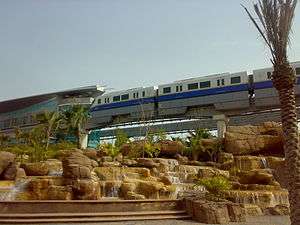Hitachi Monorail

Tama Toshi Monorail, a "Large" Hitachi monorail system
The Hitachi Monorail System refers to the family of monorails offered by Hitachi, Ltd.
List of notable Hitachi monorails[1]
Hitachi's designs are ALWEG-based, and are available in three configurations:
| Type | Capacity | Axle load | Track beam | Maximum grade | Curving radius |
|---|---|---|---|---|---|
| Large | 415 | 11 t (11 long tons; 12 short tons) | 850 mm × 1,500 mm (33.46 in × 59.06 in) | 6% | 70 m (229.66 ft) |
| Standard | 348 | 10 t (9.8 long tons; 11 short tons) | 800 mm × 1,400 mm (31.50 in × 55.12 in) | 6% | 70 m (229.66 ft) |
| Small | 194 | 8 t (7.9 long tons; 8.8 short tons) | 700 mm × 1,300 mm (27.56 in × 51.18 in) | 6% | 40 m (131.23 ft) |
| All specifications as per Hitachi.[2] "Capacity" represents regular load (three passengers per square metre) for a four-car trainset. | |||||
Large
- Kitakyushu monorail, opened 1984
- Osaka Monorail, opened 1990
- Tama Toshi Monorail Line, opened 1998
- Line 2 & Line 3, Chongqing Rail Transit, opened 2005 & 2011
Standard
- Tokyo Monorail, opened 1964
- Okinawa Monorail, opened 2003
- Palm Jumeirah Monorail, (Dubai, United Arab Emirates) opened April 2009
- Daegu Metro Line 3, (Daegu, South Korea) opened April 2015
Small
- Sentosa Express, a smaller design, opened 2007
Joint ventures
- Kuala Lumpur Monorail, opened 2003, built by Monorail Malaysia based on Hitachi designs
- Line 2 & 3, Chongqing Rail Transit, a joint project between Hitachi and the Changchun Railway Vehicles Co., Ltd..
Picture gallery
References
- ↑ Monorail Delivery Records : HITACHI Archived July 1, 2007, at the Wayback Machine.
- ↑ System Capacity : HITACHI Archived July 1, 2007, at the Wayback Machine.
This article is issued from Wikipedia - version of the 11/17/2016. The text is available under the Creative Commons Attribution/Share Alike but additional terms may apply for the media files.








